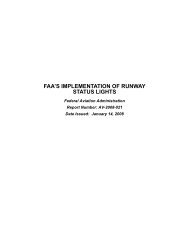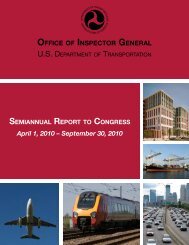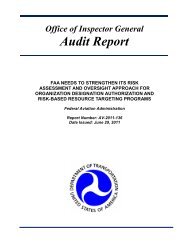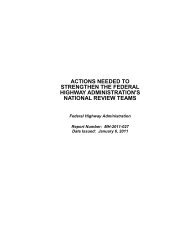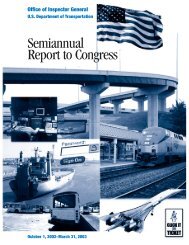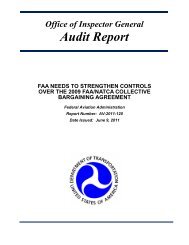Impact Magazine June 2011 - Office of Inspector General - U.S. ...
Impact Magazine June 2011 - Office of Inspector General - U.S. ...
Impact Magazine June 2011 - Office of Inspector General - U.S. ...
Create successful ePaper yourself
Turn your PDF publications into a flip-book with our unique Google optimized e-Paper software.
used by Appleby NW to construct the steel shaft casings for the<br />
light rail project did not meet the project’s contract specifcations,<br />
but neither did the samples provided to the inspector.<br />
The witness also told the agents he had recently seen the<br />
Appleby NW employee who had cut the coupons and switched<br />
the samples. The witness said that the employee no longer<br />
worked for Appleby NW but was worried because he knew the<br />
agents wanted to talk to him. He was certain that OIG knew<br />
about the false coupons and he feared he’d be arrested. The case<br />
was turning into one that everyone involved in the investigation<br />
feared most: one that could potentially impact the safety <strong>of</strong> the<br />
new light rail.<br />
The agents knew that all the mill test reports they had<br />
identifed stated that the coupons’ structural properties were<br />
grade 36 steel and the contract specifcations called for grade<br />
50 steel. They had the September 7, 2005, letter from Appleby’s<br />
steel supplier that indicated the steel was manufactured and<br />
made in the United States, and that the steel met all the chemical<br />
and physical requirements <strong>of</strong> grade 50 steel. But how could the<br />
company make this claim when the letter was attached to mill test<br />
reports that showed the steel referenced in the letter was actually<br />
grade 36 steel?<br />
The agents decided to contact the author <strong>of</strong> the letter,<br />
a sales representative who worked for the steel supplier. The<br />
salesman reviewed the letter and unequivocally denied ever writing<br />
it. He stated that the signature on the letter was not his, and<br />
moreover, the information in it was untrue. He told the agents<br />
that none <strong>of</strong> the mill tests reports that his company provided to<br />
Appleby NW for the steel used on the light rail project met the<br />
minimum yield strength required for 50 grade steel. Furthermore,<br />
he said he would have never written the letter because he did not<br />
have the authority to make claims about the physical properties<br />
<strong>of</strong> steel; it was not in his job description and was against company<br />
policy for him to provide that kind <strong>of</strong> analysis. He looked in the<br />
fle he kept marked “Appleby NW” and could not locate the letter<br />
or anything like it.<br />
He told the agents he had last spoken with David<br />
Appleby in <strong>June</strong> 2008, when Appleby had called to request that<br />
the company send him copies <strong>of</strong> a large amount <strong>of</strong> old mill test<br />
reports for steel purchased many years before. He had faxed David<br />
Appleby 139 mill test reports in response to this request and<br />
he subsequently provided copies <strong>of</strong> these reports to the agents.<br />
IMPACT <strong>Magazine</strong> • <strong>June</strong> <strong>2011</strong><br />
They also asked for samples <strong>of</strong> his signature, which he willingly<br />
provided. He told them that Appleby had said he had recently<br />
sold the company, but he was staying on as an employee.<br />
The agents sent the handwriting samples to a certifed<br />
forensic document examiner for handwriting analysis. The<br />
examiner concluded that “the questioned signature had many <strong>of</strong><br />
the same qualities <strong>of</strong> a simulated signature and was probably not<br />
signed by” the sales representative.<br />
Safety First<br />
When the engineer who was responsible for project oversight<br />
at Sound Transit was interviewed, he said that he became<br />
aware <strong>of</strong> the steel grade discrepancy in September 2005. A subordinate<br />
told him that Appleby NW was claiming that the yield<br />
strength <strong>of</strong> the steel was dual certifed as both 36 and 50 grade<br />
steel, but in order to use grade 36 steel, Appleby would have<br />
had to get authorization from Sound Transit, which they had not<br />
done. By the time this discrepancy was discovered, there were<br />
already dozens <strong>of</strong> these casings in the ground so a team <strong>of</strong> engineers<br />
at Sound Transit had the steel independently tested, and it<br />
was determined that the steel met acceptable safety standards.<br />
The agents and the prosecutor met with FTA <strong>of</strong>fcials to<br />
brief them on their fndings and were told that they were waiting<br />
on the requested certifcations from Sound Transit about the<br />
safety <strong>of</strong> the steel Appleby NW used for the project; however, in<br />
light <strong>of</strong> the information the agents and the prosecutor provided,<br />
FTA <strong>of</strong>fcials decided to hire their own expert to conduct an<br />
independent review <strong>of</strong> the structural integrity <strong>of</strong> the steel shaft<br />
casings.<br />
Appleby Comes In<br />
TRANSPORTATION SAFETY CRIMES<br />
By October 2008, David Appleby knew that Federal<br />
investigators were closing in, so he hired an attorney who contacted<br />
the U.S. Attorney’s Offce and a meeting was held between<br />
Appleby, his attorney, an engineer Appleby had hired, the special<br />
agents and the prosecutor at the U.S. Attorney’s Offce in Seattle.<br />
Appleby explained that after he won the bid to construct the steel<br />
shaft casings, he discovered that the contract specifed that they<br />
be fabricated from grade 50 steel and he had based his bid on the<br />
cost <strong>of</strong> procuring grade 36 steel. The mistake was going to cost<br />
him an additional 50 cents for each 100 pounds <strong>of</strong> steel, and he<br />
had to purchase 1.5 million pounds <strong>of</strong> steel.<br />
31



